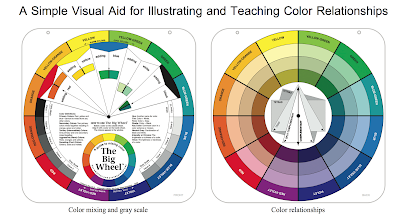Color Wheel Revisited
We will be using the triadic color wheel from the Color Wheel Company to illustrate color relationships. a good resource is the book, Color is Everything, by Dan Bartges, a book with thorough descriptions of this tool (I will have it in the workshop for you to peruse).
Triadic Color Wheel from the Color Wheel Company:
Study of the Triadic Color Wheel. The color wheel provides 12 hues around the circle on each side On the one side we can see the effects of mixing red, yellow and blue and white and black with each of the 12 hues by rotating the wheel. This side also has a value scale that can be matched up with each of the hues to identify the value of each hue.
The second side shows the tint, tone and shade for each of the hues. Directions are provided for determining analogous colors, complementaries , split complements, triads and tetrads. We will be discussing these at length. For a preliminary website link with definitions see: http://www.tigercolor.com/color-lab/color-theory/color-theory-intro.htm
==================================
Blank Color Wheel from The Color Wheel Company:
Workshop Demonstrations/exercises: note that the assumption of 'primary' means that it has no trace of the other primaries in it. The usual paints are not pure primaries so we try to choose the best ones we have. How good a choice are they? Study the mixes of the two primary sets we have: 1) Cadmium Yellow Medium, Cadmium Red Medium and Ultramarine Blue and 2) Hansa Yellow Pale, Quinacricone Red and Phthalo Blue. Which green mixes have the highest chroma? Which violet mixtures? Which oranges? Why? We note that any colors that contain some of each primary are more neutral than those with only one or two primaries. Do any of the twelve on the color wheel have more than two primaries in theory?
Note that you may use your own choice of primaries; study them. Do they have a bias toward any of the other two primaries? Compare them with the primaries on the color wheel.
Before painting the blank color wheel we will practice mixing secondaries, tints and tones. We will also test complementaries.
Secondaries: mixes of two primaries (aka orange, green and purple/violet)
Tints: colors mixed with white
Tones: colors mixed with grays (or neutralized with their complements
For the following exercises you could be making charts or color wheels on the paper or canvas sheets provided.
- mix each of paints from the two sets of 'primaries' with each other. (see #4) Which mixes are brighter? Which pairs are more neutralized?
- mix a black from each primary set.
- mix a gray from the black by adding white.
- If you have both sets of primaries make a chart mixing all six with each other. What have you noticed?
- Mix complements (e.g., red and green, blue and orange, yellow and purple). What results do you get?
- (Optional: make the following color wheel and color charts as practice before beginning the blanks )
 |
| Color Wheel |
 |
| Color Value Chart |
 |
| Color Complementary Chart |
Exercise: After doing these exercises we are ready to begin painting the color wheel following the instructions in the package. Note that you could use the suggested three primary substitutes, cad yellow medium, cad red medium and cobalt (we use ultramarine blue) or phthalo blue, quinacridone red and hansa yellow pale and mix all the secondaries and tertiaries from these. Or you can use your own primaries, first identifying as closely as possible the paint hue/colors you use. If you use your own palette you should identify the RED, YELLOW and BLUE closest to the three on the wheel that will be mixed with each of the other colors. If you use your palette, it would be instructive to compare the resulting secondaries with the ones on the color wheel as suggested in the previous set of exercises.
After experimenting with the mixing, you might decide to use your whole palette for the color wheel, identifying as best you can which ones match the mixes the best. You might want to check the following color wheels or handouts for suggested pigments.
And of course the suggested alternative of the split-primary or double-primary palette with both of these primary sets used as described in the exercise.
And of course the suggested alternative of the split-primary or double-primary palette with both of these primary sets used as described in the exercise.
To be analyzed:
The Hal Reed wheel is more useful. This is the one my painting pal uses.
===========================================================
Margaret Kessler Munsell Color Wheel:
The Munsell Color Wheel is based on 10 hues: 5 major hues: Yellow, Red, Purple, Blue and Green, with intermediate mixtures. Kessler states that the complements formed by these hues (across the wheel) generate more exciting color schemes. Future exercise: paint the same scene twice, with color complements based on each of these 'wheels'. The differences are clearer if diagrams are seen together:
==========================================================
(Extra) Click on the See Color Mixing Guide Poster in the middle of the Golden Site for a pdf of the Golden Color Mixing Palette from Modern Colors. For a useful -but sometimes difficult-color mixing tool on the Golden site click here: http://www.goldenpaints.com/mixer or in general: useful acrylic mixing information, http://www.goldenpaints.com/technicalinfo_mixguide and uses its own color wheel:
==========================
=================================================
Note: it might be of interest to look at the end of the Additonal Material Post at MacEvoy's lists of colors on the color wheel.












